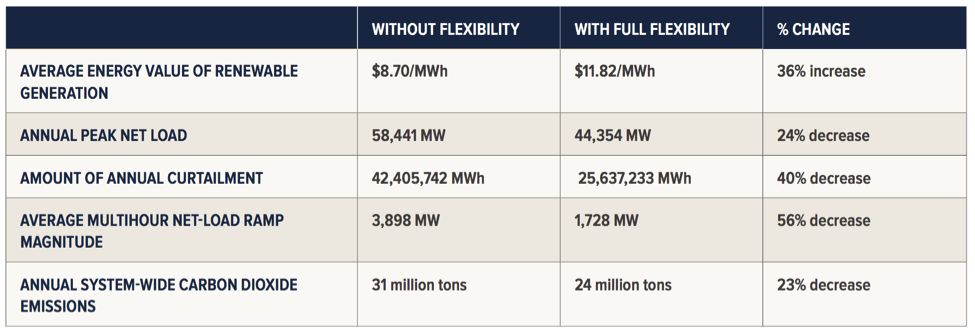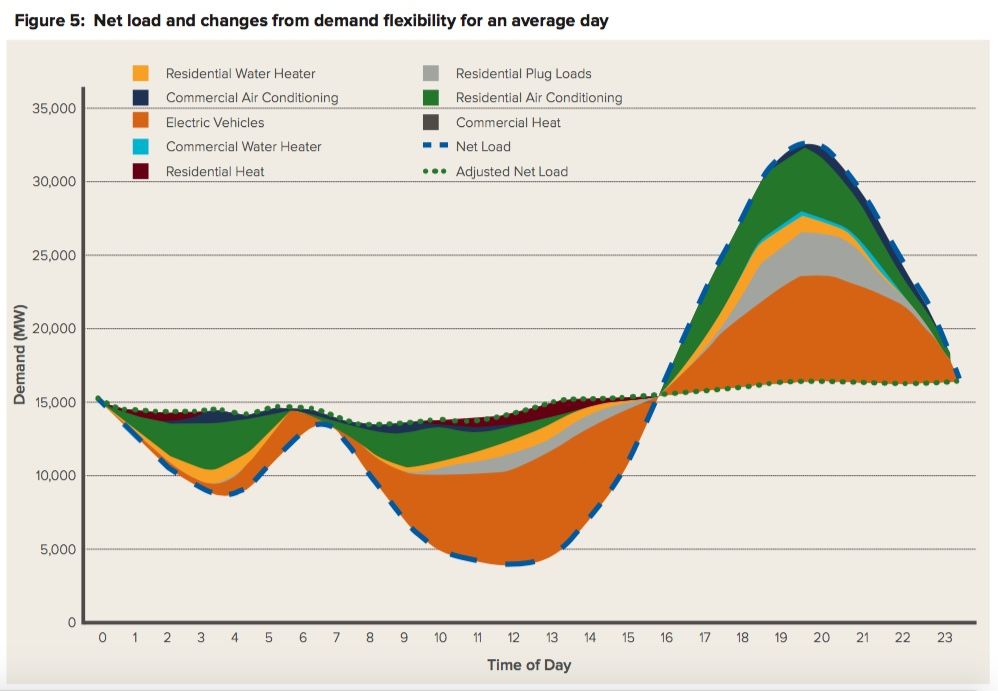‘Demand flexibility' is Rocky Mountain Institute’s term for the capability of water heaters, air conditioners, plug-in electric vehicles, and other loads to provide a massive set of benefits to the grid -- if they’re smart enough to handle it.
On Wednesday, RMI released a new report on the demand flexibility equation, modeled on America's version of an islanded energy market -- Texas’ transmission power grid. The results, run over hourly forecasts through an entire year, indicate that the investment in demand flexibility would more than pay for itself in reduced curtailment, flattened peaks, and power plants never built.
The model forecasts high future solar and wind growth on the state’s existing market structures and resources, then adds in tens of millions of demand flexibility assets -- to be precise, 4.2 million residential and commercial water heaters, 3.9 million home and business ceramic brick heat storage systems, 3.7 million ice energy AC systems, 15 million household plug loads, and 11.5 million grid-responsive electric vehicles.
Using this fleet of fast-responding yet reliable aggregate flexibility allowed RMI to increase renewables revenues by 36 percent compared to a system with inflexible demand. The model also reduced renewable curtailment by 40 percent, lowered peak demand net of renewables by 24 percent, and lessened the average magnitude of the multi-hour ramps that characterize the solar-rich, evening-peaking scenario known as the “duck curve” by 56 percent.
A flexible demand fleet of this scale could also avoid $1.5 billion per year in annualized generator and transmission and distribution capital costs, along with $400 million in avoided fuel costs and 6 million tons per year of carbon emissions -- roughly one-fifth of the state’s emissions over that time.

“What we’ve shown in this paper is the potential for demand flexibility to act at the multi-gigawatt scale in the Texas power system to ease renewables integration,” Mark Dyson, RMI principal and co-author of the report, said in an interview this week.
Of course, this fleet of fast-reacting, IP-addressable distributed loads isn’t available to meet Texas’ grid needs at present. “That level of command and control doesn't exist today at that scale," said Dyson. "It's important to be upfront about that.”
Still, RMI’s report highlights the long string of utility and grid operator pilot projects indicating that distributed, aggregated demand-side resources are capable of serving these needs. “This starts to calculate confidence that you can push a button and have load response,” Dyson said.
Once this confidence barrier is breached, we could soon see a mass rollout. “There are already hundreds of thousands of interactive water heaters on the grid today -- we’re just adding a chip," he said.
The benefits of smart technologies outweigh the costs
RMI’s incremental cost projections on a per-unit basis for its basket of technologies is culled from industry interviews. Costs range from $5 per water heater and $10 per household plug load -- presuming they’re modern enough to have the industry-standard digital interface being developed for plug-and-play applications such as these -- up to $100 per networked, responsive EV.
As for the two energy storage technologies, RMI’s report priced them at $50 per kilowatt-hour for ceramic brick heating storage and $228 per kilowatt-hour for ice-making air conditioning system of the kind built by Ice Energy. Importantly, these costs include all the upfront capital of the systems themselves, unlike the per-unit costs for the other technologies modeled, Dyson noted.
These costs shook themselves out in the analysis, with RMI choosing to front-load the cheapest technologies, some of which actually paid for themselves when compared to their share of avoided costs. “Water heaters, EVs, and plug loads require only a relatively small investment in communications technologies to enable flexibility,” all at costs that are more than outweighed by their commensurate share of per-unit benefits to the range of improvements laid out in the model.
In fact, while commercial building space heating comes with extra costs for dedicated thermal storage capacity, it more than makes up for that cost in its assistance in reducing winter peaks. That gives it a massive per-unit benefit in terms of reducing renewable energy curtailment in RMI’s model, given that West Texas wind is most often curtailed in wintertime.
Residential plug loads, EVs and grid-responsive water heaters were also cost-effective in reducing curtailment, given their low per-unit costs. Residential thermal heat and ice storage, which cost thousands of dollars, weren’t as effective in reducing curtailment, but ice-cooled AC did help reduce summer peaks.

Source: RMI
Capital-intensive technologies also suffered from the fact that, in RMI’s model, they were implemented after everything less expensive had already had a chance to reduce the highest marginal costs associated with avoided curtailments, demand peaks and gas-fired power generation, noted Cara Goldenberg, an associate with RMI's electricity practice and report co-author. As the beneficial effects of flexible demand feed back into lower market clearing prices for peak hours and reduced curtailment, revenues for renewable energy in the state's market also increased, she noted.
RMI didn’t model standard air conditioning and heating demand response systems, choosing instead those technologies that come with some form of storage, to provide more certainty that they’ll be available both at a moment’s notice and for potentially multi-hour blocks of time. That’s because demand flexibility is expected to be reliable and secure enough to avoid new power plants that will take at least five years to bring online, Dyson said.
Proof that gas isn't the only answer
Utilities are still taking their first tentative steps toward relying on distributed, demand-side energy resources like these to replace future power plants, led by California’s investor-owned utilities and extending to other solar-rich states such as Hawaii and Arizona.
Dyson hopes that RMI’s analysis can help Texas state grid operator ERCOT, along with other states and grid operators facing decisions on how to integrate more and more wind and solar onto their grids, avoid assuming that more natural-gas-fired power plants are the answer.
“We have seen a lot of analysis come out that says, 'We can't make it to X percent renewables because there's this fundamental mismatch,'” he said. “What we've done in this paper is say exactly how much, with a representative sample of demand flexibility, we can solve that problem.”





